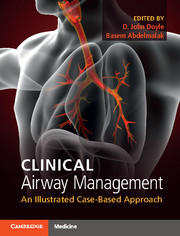Book contents
- Clinical Airway ManagementAn Illustrated Case-Based Approach
- Clinical Airway Management
- Copyright page
- Dedication
- Contents
- Contributors
- Foreword
- Preface
- Acknowledgments
- Section 1 Introduction
- Section 2 Basic Airway Management
- Section 3 The Anticipated Difficult Airway
- Section 4 The Unanticipated Difficult Airway
- Section 5 Lower Airway Management
- Section 6 Airway Emergencies and Special Situations
- 37 Airway Management of a Dyspneic Patient with a Le Fort Fracture
- 38 Awake Tracheostomy in a Stridorous Patient
- 39 Intubating the Combative Trauma Patient in the Emergency Department
- 40 Airway Bleed Following Partial Cordectomy
- 41 Airway Management in Bullous Emphysema
- 42 Capnogram Problems: Clinical and Technical Aspects
- 43 Airway Management in a Patient with an “Uncleared” Cervical Spine
- 44 Adult and Pediatric Epiglottis
- 45 Airway Management in Aeromedical Evacuation
- 46 An Inhalation Induction Gone Wrong
- 47 Intubating the Patient with Loose Teeth
- 48 Airway Management for Ludwig's Angina
- 49 Airway Management for an Expanding Neck Hematoma
- 50 Tracheal Rupture
- 51 Double Lumen Tube for Single-Lung Ventilation
- 52 Airway Management in Lung Transplantation
- 53 Pulmonary Artery Rupture
- 54 Regional Anesthesia in the Difficult Airway Patient
- 55 Channel-Blade Video Laryngoscopy for Endotracheal Tube Exchange in Complex Clinical Situations
- 56 Whole Lung Lavage
- Section 7 When the Airway Goes Bad
- Appendix: The Art and Science of Awake Fiberoptic Intubation
- Index
- References
45 - Airway Management in Aeromedical Evacuation
from Section 6 - Airway Emergencies and Special Situations
Published online by Cambridge University Press: 03 March 2017
- Clinical Airway ManagementAn Illustrated Case-Based Approach
- Clinical Airway Management
- Copyright page
- Dedication
- Contents
- Contributors
- Foreword
- Preface
- Acknowledgments
- Section 1 Introduction
- Section 2 Basic Airway Management
- Section 3 The Anticipated Difficult Airway
- Section 4 The Unanticipated Difficult Airway
- Section 5 Lower Airway Management
- Section 6 Airway Emergencies and Special Situations
- 37 Airway Management of a Dyspneic Patient with a Le Fort Fracture
- 38 Awake Tracheostomy in a Stridorous Patient
- 39 Intubating the Combative Trauma Patient in the Emergency Department
- 40 Airway Bleed Following Partial Cordectomy
- 41 Airway Management in Bullous Emphysema
- 42 Capnogram Problems: Clinical and Technical Aspects
- 43 Airway Management in a Patient with an “Uncleared” Cervical Spine
- 44 Adult and Pediatric Epiglottis
- 45 Airway Management in Aeromedical Evacuation
- 46 An Inhalation Induction Gone Wrong
- 47 Intubating the Patient with Loose Teeth
- 48 Airway Management for Ludwig's Angina
- 49 Airway Management for an Expanding Neck Hematoma
- 50 Tracheal Rupture
- 51 Double Lumen Tube for Single-Lung Ventilation
- 52 Airway Management in Lung Transplantation
- 53 Pulmonary Artery Rupture
- 54 Regional Anesthesia in the Difficult Airway Patient
- 55 Channel-Blade Video Laryngoscopy for Endotracheal Tube Exchange in Complex Clinical Situations
- 56 Whole Lung Lavage
- Section 7 When the Airway Goes Bad
- Appendix: The Art and Science of Awake Fiberoptic Intubation
- Index
- References
- Type
- Chapter
- Information
- Clinical Airway ManagementAn Illustrated Case-Based Approach, pp. 235 - 241Publisher: Cambridge University PressPrint publication year: 2000

